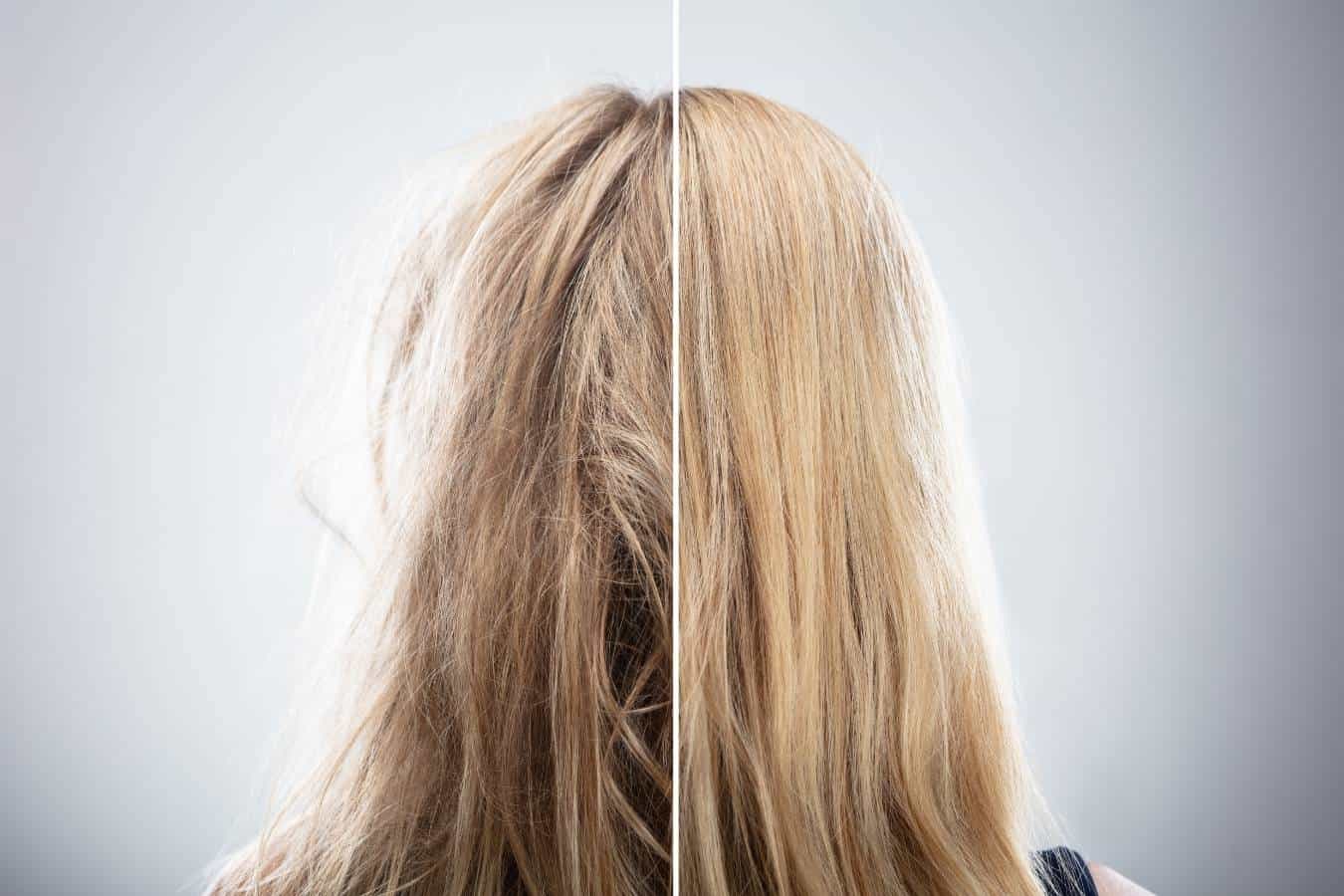Excessive styling and use of products, chemicals, and heat can lead to damaged hair cuticles. Although damaged hair can be difficult to fix, it is not impossible. In this article we’ll go through the steps you need to repair damaged hair cuticles.

To repair damaged hair cuticles, use leave-in conditioners and hydrate your hair using natural, protein-filled hair masks made of eggs, butter, or avocados. Other natural options include using coconut or olive oil in your hair.
What Is A Hair Cuticle?
Your hair is made up of 3 separate sections, with the inner-most section called the medulla, followed by the cortex, and finally, the hair cuticle that sits at the very outside of the hair strand.
A hair cuticle is, in essence, what protects the hair strand and holds it together.
Also Read: Revealed: Can I Use Shea Butter In Hair Overnight?
Signs That Your Hair Cuticles Are Dry and Damaged
If you have healthy hair, the cuticle isn’t damaged and holds together the strands of your hair while having a smooth, shiny surface.
However, once you start using lots of chemicals, hair dyes, heat, or you’re too rough with your hair, the hair cuticle breaks apart. This exposes the inner parts of the hair strand.
On a microscopic level, this may look a lot like the leg of a hairy and or small insect.
To the naked eye, damaged cuticles can appear as:
Frizz
Hair that has damaged cuticles will be more prone to dryness and can appear frizzy, even in weather that’s not humid.
As the cuticle is damaged, more moisture is now allowed into the cuticle, causing the hair to swell within the hair shaft and become frizzy.
Split Ends
Split ends might be a sure sign of damaged hair cuticles.
These occur when the ends of your hair, which are the weakest and most vulnerable parts, begin to split apart into a “Y” shape or thinning.
Split ends can also happen in the middle of your hair strands.
Dry Hair
Dry hair may indicate that your hair cuticles are damaged.
To check whether your hair is dry, fill up a bowl or sink with water.
Let your hair soak in it, and see if it sinks quickly or floats.
Healthy hair with natural oil will repel water and won’t soak up as much, floating easily.
Hair that has cuticles that are damaged and dry will soak up much more water, sinking to the bottom quickly.
Hair That Doesn’t Shine
If you notice your hair is dull, this is probably a sign that all the natural oils in your hair have been stripped away. This causes cuticles to be damaged and your hair to be dull.
Hair that remains dull even after putting in moisturizer such as leave-in conditioner is more than likely damaged.
Tangled Hair
If your hair tangles easily, this is a sign that the raised cuticles in your hair are causing more friction. this will cause more tangling.
If you’re unable to detangle your hair by just running your fingers through your hair, or have tangled hair more often than normal, you may have damaged hair cuticles.
Your Hair Breaks
If your hair easily breaks, your hair cuticles are most likely damaged.
Damage could be attributed to anything from stress, heat styling, or chemicals.
These processes can cause the hair cuticle to break off typically in the middle of the hair.
Breakage can sometimes be scary. Many people might think they’re actually losing hair as opposed to simply having their hair break off.
Fortunately, breakage is often only temporary and can be fixed using the right methods.
Be aware, however, that if you do have breakage, this is a sign of severely damaged hair that you should start treating as soon as possible.
Also Read: 5 Important Benefits Of Drinking Water For Hair (Top Tips)
How To Repair Damaged Hair Cuticles

Trim your Hair
This is one of the easiest hair cuticle repair methods to prevent split ends from traveling up your root and causing more hair cuticle damage.
Deep Condition
Deep conditioning can be done around 3-4 times a month, and many deep conditioning products are available to bring moisture back to dry hair and do hair cuticle repair.
It’s important to apply the conditioner evenly on all strands, wash it out with cold water, and do it after shampooing.
Use Home Remedies
Eggs, avocado, coconut oil, and olive oil are all at-home products you can use that have natural healing and restorative properties for hair.
You can even combine using these with conditioning.
Simply condition your hair, and then apply the avocado mask, eggs, or oil and leave it in your hair until you wash everything off.
How To Prevent Hair Damage
To help you prevent further damage, here are some tips.
Lay Off The Heat
One of the easiest things you can do to avoid cuticle damage and start hair cuticle repair is to lay off the heat.
Don’t blow dry your hair unless you absolutely have to, and let it air dry instead.
Heat your hair only once a week, and less if you notice you have severe breakage or split ends.
If you are going to use heat, try a heat protectant and apply it before you curl or flat-iron your hair.
This adds an extra layer of protection to your hair.
Don’t Brush Wet Hair
When your hair is wet, it is the most vulnerable to stretching, breakage, and cuticle damage.
Never brush your hair when it’s wet, and always wait for it to air dry naturally.
You can also wrap wet hair in a towel, but don’t rub your hair, as this can cause damage to the cuticle and frizz.
Avoid Excessive Dyeing And Bleaching
We know, it’s fun to change your hair and style, but doing it too often can cause serious damage.
If you are going to dye and bleach your hair, it’s best to wait 2 weeks in between each treatment to give your hair time to repair itself.
It’s also best to get these treatments sparingly and with the help of a professional hairstylist.
Cut Back On Shampoo
Shampoo is made to strip dirty debris and oil from hair, but shampooing too often dries out hair from its natural oils and leads to brittle, damaged cuticles.
If you are going to shampoo, do so about one to two times a week, and use a shampoo that has a neutral pH level that is sulfate and paraben-free.
For dry hair, specially formulated shampoos also have natural oils to help restore your hair health.
Moisturize Often
It’s no secret that moisturizing and deep-conditioning your hair is the best defense against damaged cuticles.
You should always use a conditioner after shampooing, especially if you’ve been dying or heating your hair excessively recently.
Also Read: Should I Use Heat To Deep Condition? (Best Results)
How Do Hair Cuticles Become Damaged?

By far, the most common causes of cuticle damage happen because we ourselves are damaging our own hair.
However, there are some instances where other things happening with our body might be causing hair cuticles to be damaged.
To prevent your hair cuticles from becoming damaged, it’s important to know what exactly is causing the cuticle to be stripped away and broken.
Below are some of the most common causes of hair cuticle damage:
Using Excessive Heat
One of the most common reasons hair cuticles become damaged is due to excessive heat.
Treating hair with heat not only damages the hair shaft but also dries out the hair of its natural oils and moisture, leading to split ends and damaged cuticles.
Heat damage can occur from flat-ironing, hot brushes, blow-drying, and also curling.
Dyeing Your Hair
Hair dye works by penetrating the hair cuticle, entering the 2nd outer-most layer of the hair called the cortex, and attaching its color to the hair.
Although hair dye might feel good on your hair and might seem as if it’s full of moisture, this is often not the case.
Hair dye damages hair, especially permanent hair dye, because it contains chemicals such as ammonia and peroxides, and also dries hair out over time.
This is especially true if you dye your hair often.
Bleaching Or Using Other Chemicals On Your Hair
Depending on what color you want to use on your hair, you’ll have to bleach your hair beforehand to get a well-defined color.
Unfortunately, bleaching your hair strips the natural melanin from your hair by opening up and damaging the hair cuticle. Bleach then goes directly into the hair shaft, breaking down the hair’s pigments.
Bleaching might leave you with stunning results. However, the truth of the matter is that no matter where you get your hair bleached, whether at home or at a salon, it will always lead to hair cuticle damage.
Not Moisturizing Enough
With our busy schedules, it can be difficult to maintain a good hair hygiene routine, especially if we just don’t have time to condition and moisturize our hair.
Unfortunately, not moisturizing your hair enough with conditioners is one of the most common causes of dry hair and damaged hair cuticles.
Tying Your Hair Too Tight
Tying your hair in a tight ponytail, bun, or cornrows can damage hair cuticles since you are physically restricting them.
This is especially true if you tie your hair when it’s wet, as this is when it is the most vulnerable!
Unhealthy Eating Habits
There are many vitamins that are scientifically proven to help your hair stay healthy and damage-free! These include:
- Vitamins D
- Vitamin E
- B complex vitamins
These vitamins can usually be found in everyday foods, however, they are also popular now in tablets.
However, it’s best to get your vitamins through a well-balanced diet, as this makes it easier for your body to absorb and process vitamins.
Not drinking enough water or eating an unhealthy diet doesn’t allow your body to get any of the benefits from these vitamins, causing your hair to be unhealthy and dry.
Stress
Stress has been linked to a number of health conditions. One of these is known as telogen effluvium, a condition where the hair follicle becomes inactive and stops growing.
This can cause breakage in existing hair and cuticle damage.
Medical Conditions
Some medical conditions have been linked to hair damage.
This includes hypothyroidism, heart disease, lupus, skin disorders, and anemia.
It’s important to speak to your doctor if you feel one of these conditions is impacting not just your hair, but your overall health.
Your doctor can help find solutions to help you, and your hair, get nursed back to full health.
Sun Damage
UV exposure can over time lighten and damage your hair. UV exposure leads to the hair’s natural bonds breaking, leading to hair damage and breakage!
Excessive Brushing
It might seem counter-intuitive to not brush your hair if it seems frizzy, dry, and tangled from damaged cuticles.
However, excessively brushing your hair leads to hair cuticle damage as it stretches out the hair, especially when brushing wet hair.
Brushing raises up the natural scales that criss-cross in a cuticle, leading to excessive friction and breakage.
Disclaimer: This site is not intended to provide professional or medical advice. All of the content on LovedByCurls.com is for informational purposes only. All advice should be followed at your own discretion. Ingredients may change at any time so always check the product label before using. Check our full disclaimer policy here.
